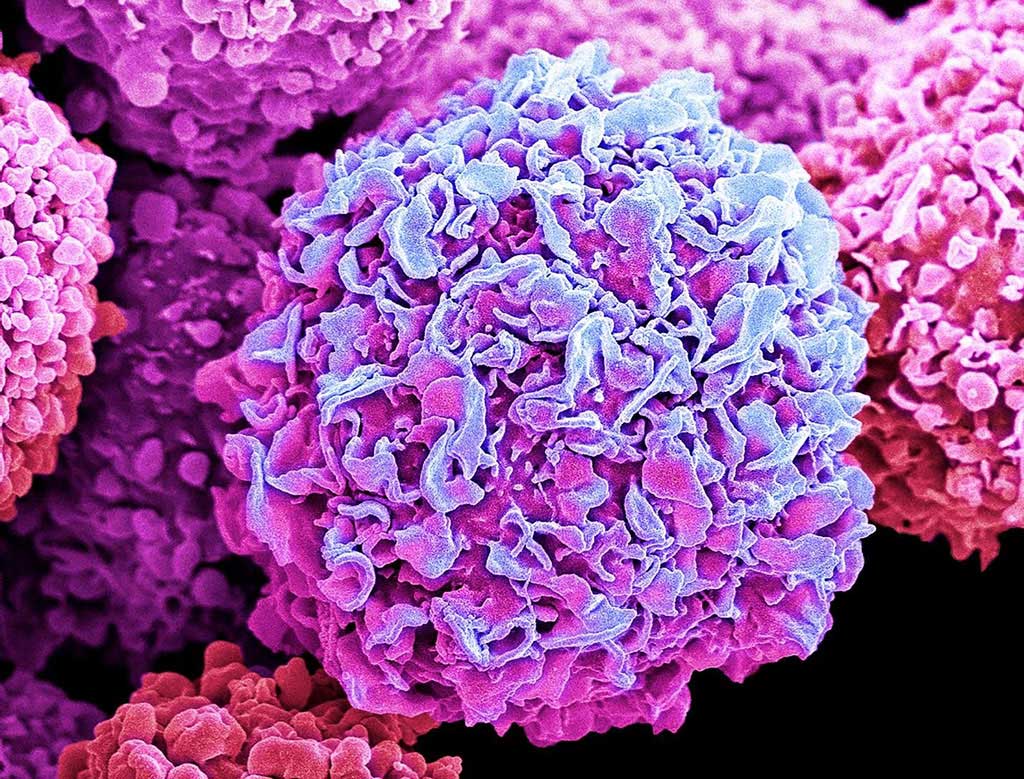Biomarker FR+CTC Explored for Breast Cancer Diagnosis
By LabMedica International staff writers
Posted on 30 Dec 2021
The prognosis of breast cancer is dramatically improved owing to progress on the early diagnosis and effective therapy, and the survivor number is higher than any other types of cancers. However, the number of new breast cancer cases reached 2.26 million in 2020, accounted for 11.7% of all new tumor cases.Posted on 30 Dec 2021
Folate receptor (FR) is a glycosylated phosphatidylinositol-coupled protein with high affinity and endocytosis and transport capacity for its natural ligand folic acid. It is a cell surface protein that has been proven to be an ideal tumor marker for non-small cell lung cancer. The clinical significance of folate receptor-positive circulating tumor cells (FR+CTC) has been explored.

Image: A colored scanning electron micrograph (SEM) of a breast cancer cell (Photo courtesy of Case Western Reserve University School)
Clinical Laboratorians at the Renmin Hospital of Wuhan University (Wuhan, China) enrolled in a study 60 breast cancer female patients with a mean age of 52 years (range, 27–75 years) and 32 healthy controls with an age of 52 (range, 40–66 years), from January 2019 to January 2021. The diagnosis for the patients was confirmed by cytology or histopathology. Peripheral blood was collected for isolation of circulating tumor cells (CTC) on the diagnosis in all patients of the cohort. The 27 patients underwent radical mastectomy, and the peripheral blood was also collected in two weeks after the operation.
Circulating tumor cells was isolated with folate receptor-positive (FR+) CTC isolation method using CytoploRare kit (GenoSaber Biotech Co., Ltd., Shanghai, China). The method includes negative enrichment of FR+ circulating tumor cells with immunomagnetic beads to deplete leukocytes first, then CTC level was quantitated by ligand-targeted PCR. First, leukocytes and mononuclear macrophages were removed by anti-CD45 and anti-CD14 magnetic beads. Then, the cells were activated and washed to free up the folate binding site. The carcinoembryonic antigen (CEA), cancer antigen 125 (CA125), and cancer antigen 153 (CA153) were measured by chemiluminescent immunoassay.
The investigators reported that the levels of FR+CTC were significantly higher in breast cancer patients compared with healthy controls. The levels of FR+CTC in breast cancer patients and healthy people were 10.95 (7.28–14.15) FU/3 mL and 6.93 (5.46–8.19) FU/3 mL, respectively. The detection rate of FR+CTC was decreased in 19 of 27 patients underwent the surgery in two weeks post-operation compared with pre-operation; statistical analysis showed the difference was significant. They also found that the combination of FR+CTC, CEA, CA125, and CA153 can significantly improve the diagnostic efficiency for breast cancer.
The authors concluded that the detection of FR+CTCs in peripheral blood is simple, noninvasive methods with high sensitivity and specificity. It can be used as a potential biomarker for auxiliary diagnosis and early detection in breast cancer patients. The study was published on December 17, 2021 in the Journal of Clinical Laboratory Analysis.
Related Links:
Renmin Hospital of Wuhan University
GenoSaber Biotech Co., Ltd.










 (3) (1).png)


